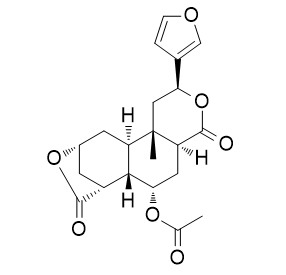8-Epidiosbulbin E acetate
8-Epidiosbulbin E acetate exhibits broad-spectrum plasmid-curing activity against multidrug-resistant (MDR) bacteria, including vancomycin-resistant enterococci. It also exhibits time-and dose-dependent liver injury in mice.
Inquire / Order:
manager@chemfaces.com
Technical Inquiries:
service@chemfaces.com
Tel:
+86-27-84237783
Fax:
+86-27-84254680
Address:
1 Building, No. 83, CheCheng Rd., Wuhan Economic and Technological Development Zone, Wuhan, Hubei 430056, PRC
Providing storage is as stated on the product vial and the vial is kept tightly sealed, the product can be stored for up to
24 months(2-8C).
Wherever possible, you should prepare and use solutions on the same day. However, if you need to make up stock solutions in advance, we recommend that you store the solution as aliquots in tightly sealed vials at -20C. Generally, these will be useable for up to two weeks. Before use, and prior to opening the vial we recommend that you allow your product to equilibrate to room temperature for at least 1 hour.
Need more advice on solubility, usage and handling? Please email to: service@chemfaces.com
The packaging of the product may have turned upside down during transportation, resulting in the natural compounds adhering to the neck or cap of the vial. take the vial out of its packaging and gently shake to let the compounds fall to the bottom of the vial. for liquid products, centrifuge at 200-500 RPM to gather the liquid at the bottom of the vial. try to avoid loss or contamination during handling.
Antiviral Res.2021, 193:105142.
Food Chem.2019, 290:286-294
Nat Commun.2023, 14(1):4540.
Heliyon.2023, e12684.
J. Mater. Life Sci.2024, 3:2:78-87
Nat Commun.2023 Dec 20;14(1):8457.
Natural Product Sciences2024, 30(4):309-315.
Toxins (Basel).2021, 13(12):898.
Journal of Functional Foods2017, 30:30-38
Mediators Inflamm. 2016, 2016:6189590
Related and Featured Products
Int J Antimicrob Agents. 2008 Nov;32(5):405-10.
A potential plasmid-curing agent, 8-epidiosbulbin E acetate, from Dioscorea bulbifera L. against multidrug-resistant bacteria.[Pubmed:
18718743]
Bioassay-guided fractionation of an aqueous methanolic extract of Dioscorea bulbifera L. bulbs was performed using organic solvents.
METHODS AND RESULTS:
A novel plasmid-curing compound was identified as 8-Epidiosbulbin E acetate (EEA) (norditerpene) on the basis of modern spectroscopic analysis and X-ray crystallography. EEA exhibited broad-spectrum plasmid-curing activity against multidrug-resistant (MDR) bacteria, including vancomycin-resistant enterococci. EEA cured antibiotic resistance plasmids (R-plasmids) from clinical isolates of Enterococcus faecalis, Escherichia coli, Shigella sonnei and Pseudomonas aeruginosa with 12-48% curing efficiency. The reference plasmids of Bacillus subtilis (pUB110), E. coli (RP4), P. aeruginosa (RIP64) and Salmonella typhi (R136) were cured with efficiency ranging from 16% to 64%. EEA-mediated R-plasmid curing decreased the minimal inhibitory concentration of antibiotics against MDR bacteria, thus making antibiotic treatment more effective.
CONCLUSIONS:
The antibiotic resistance pattern revealed that the compound was effective in the reversal of bacterial resistance to various antibiotics. In addition, the compound did not show any cytotoxicity against a broad range of human cancer cell lines, namely MCF-7 (breast cancer), SiHa (cervical cancer) and A431 (epidermal carcinoma), and hence has the potential to be used as a lead compound for drug discovery programmes.
Chem Res Toxicol. 2016 Mar 21;29(3):359-66.
Role of Metabolic Activation in 8-Epidiosbulbin E Acetate-Induced Liver Injury: Mechanism of Action of the Hepatotoxic Furanoid.[Pubmed:
26886724 ]
8-Epidiosbulbin E acetate (EEA), a furanoid, was unexpectedly found to be the most abundant diterpenoid lactone in certain varieties of Dioscorea bulbifera L. (DB), a traditional herbal medicine widely used in Asian nations. This herb has been reported to cause liver injury in humans and experimental animals. The occurrence of EEA in DB was dependent on its commercial source.
METHODS AND RESULTS:
The present study shows that EEA exhibits time- and dose-dependent liver injury in mice. Pretreatment with ketoconazole prevented the animals from developing EEA-induced liver injury, caused 7- and 13-fold increases in the plasma Cmax and AUC of EEA, and decreased urinary excretion of glutathione conjugates derived from EEA. Pretreatment with buthionine sulfoximine exacerbated EEA-induced hepatotoxicity. In order to define the role of EEA's furan moiety in EEA-induced hepatotoxicity, we synthesized tetrahydro-EEA by catalytic hydrogenation of the furan moiety. No liver injury was observed in the animals given the same doses of tetrahydro-EEA as those used with EAA.
CONCLUSIONS:
The results indicate that EEA itself does not appear to be hepatotoxic but that the electrophilic intermediate generated by the metabolic activation of the furan ring mediated by cytochromes P450 is responsible for EEA-induced liver injury.



